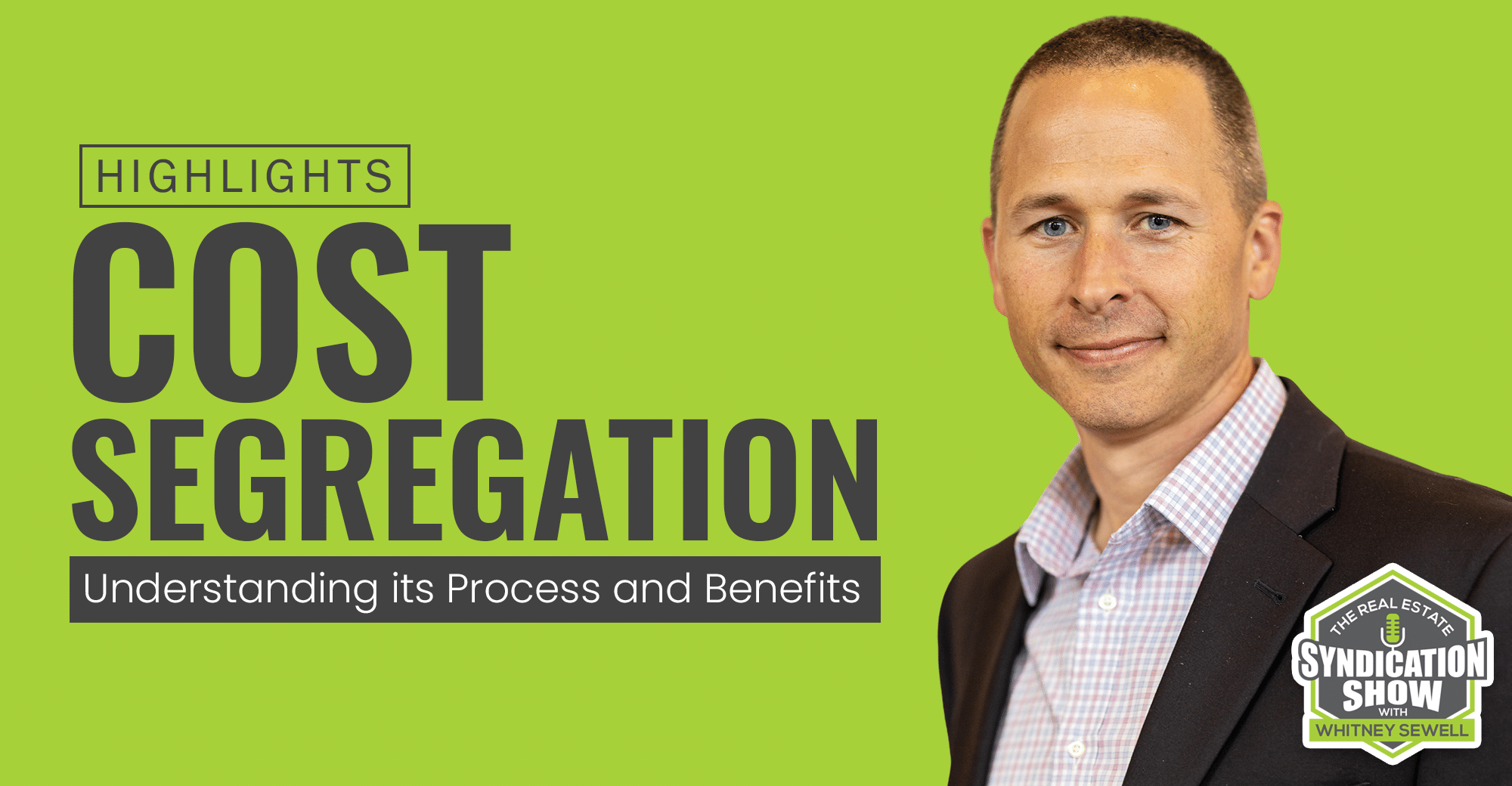
Our Gracious Sponsor:
DEAL ANALYSIS WORKSHOP
Deal Analysis. The #1 Critical Skill EVERY Multifamily Investor MUST know!
Want to take your investing career to the next level? Then check out Think Multifamily’s Deal Analysis Workshop.
For more information, go to www.ThinkMultifamily.com/daw.
Watch the episode here:
Listen to the podcast here:
Erik will discuss in detail which asset class can benefit much from cost segregation and how it works. He will also talk about the effect of tax changes that are going to take place and how you can use cost segregation to manage your tax brackets to save significantly.
Key Points From This Episode:
- What are partial asset dispositions?
- What does the Bedford Segregation team specializes in?
- The three key fiscal benefits of educating yourself and being aware of this opportunity: loss, removal or demolition cost, and ghost assets.
- What the IRS is looking for and what you’ll be taxed on: the depreciation recapture tax.
- Why it is important that you reconcile your original starting depreciable basis.
- The relationship between the segregation team and the client’s CPA.
- How cost segregation accelerates your depreciation deductions.
- Three things significantly drive down the cost of the segregation study: education, bonus depreciation, and technology.
- How do you select a good cost segregation provider?
- In which type of asset classes would cost segregation be the most or least efficient?
Tweet This!
“Your cost segregation provider needs to be your resource partner and he or she needs to make sure that they set you up correctly from the beginning.” — Frank Giudici
“Losses offset taxable income.” — Frank Giudici
“By doing a cost segregation study, it allows you to allocate the sales price to the right buckets.” — Erik Oliver
“Get yourself a good real estate CPA, good cost segregation provider who works hand-in-hand with your CPA so that you can reduce your tax liability.” — Erik Oliver
Links Mentioned in Today’s Episode:
Cost Segregation Authority website
About Frank Giudici
Frank Giudici is a Business Development Director on the Source Advisors Team. He is instrumental in fostering relationships with people who can take advantage of the value-adds that the Source Advisors team provides and constantly seeks to educate those on the subject matters of cost segregation, energy-efficiency and R&D. Prior to joining Source Advisors, Frank received his Bachelor’s Degree in Civil Engineering from Worcester Polytechnic Institute (WPI) and then spent 13-years in the Construction Management industry working throughout the Northeast on a variety of construction projects in several roles. Most recently, he served as the Procurement Manager over-seeing the buy-out strategy and implementation for multiple nanotech projects in Upstate New York. Frank’s expansive construction management background paired with his well-versed communication and detail-oriented nature bodes well for enriching peoples’ lives (pun intended).
About Erik Oliver

Full Transcript
EPISODE 1582
[INTRODUCTION]
Whitney Sewell (WS): This is your Daily Real Estate Syndication Show and I’m your host, Whitney Sewell. Today we’ve packed a number of shows together to give you some highlights. I know you’re gonna enjoy this show. Thank you for being with us today!
[INTERVIEW 1]
WS: Welcome to the show, Frank.
Frank Giudici (FG): Excellent, thank you so much for having me again, Whitney. I appreciate the opportunity.
WS: Yeah. Frank is Bedford Cost Segregation’s business development director and is here to discuss the partial asset disposition election as it pertains to commercial real estate.
Prior to joining Bedford team, one of the largest independent owned cost segregation providers in the country, Frank spent 15 years in the construction management industry with two top-ranked builders both nationally and internationally. A civil engineer by degree, Frank served as both a project engineer and procurement manager for a large-scale commercial construction across US including high-rise multifamily, nano tech manufacturing.
Frank, welcome again to the show, you definitely have an expertise that anyone in this business needs to be knowledgeable in or at least know enough to know that they need to speak to someone like yourself or have someone like yourself on their team so they can get these benefits and make sure they’re not throwing money into the dumpster, I know this happens often and people just don’t realize, right? They just don’t know but you’re going to help us to do that so I want us to really jump right in, obviously we’re short on time as we talk about the details of tax.
Let’s jump right in and explain a little bit about what partial asset dispositions are. What is that? I know many people listening think, “What is he talking about? I haven’t heard of that before.”
FG: Yeah, it’s obviously a mouthful. The bottom line is this, in 2014, the IRS came out with what was called the final disposition regs and I don’t want to get too much into the weeds but the bottom line is, this provided people an opportunity to basically write off the amount of depreciation left in assets that were being disposed of, hence, partial asset disposition — assets being disposed of as part of renovation projects. Think about this, when you buy a property, the depreciation clocks starts all over back at zero, okay? You, let’s use the multifamily world because that’s where you reside, right, Whitney?
In the multifamily world, all residential use commercial real estate depreciates over 27 and a half years. If year two, you decide to do significant renovation work to your properties, all of – let’s use the example, you’re going to go through and redo all the bathrooms, okay? All the units of a given property, you’re going to gut renovate all the bathrooms.
Think about technically, even though those bathrooms could be 50 years old, you bought them, you bought that property two years ago. You’ve only been depreciating the assets within that bathroom envelope of every unit for two years. So, 27 and a half minus two, you’re left with 25 and a half years of depreciation left.
If you’re stripping out all of the assets of every bathroom and every unit and you’re throwing it into the dumpster, many people don’t realize that there’s depreciation left in those assets that you can write off as a loss in the current tax year.
All of that money is going into the dumpster and the client never thinks to mention to their CPA and the CPA never thinks to ask the client about the extent of renovations that were performed and what type of value was left in those assets that were being thrown out.
The Bedford Cost Segregation team specializes in this type of an analysis so that we can prepare people upfront and we can do the proper things in the beginning to allow people like you in the multifamily world and in fact, I know as your cost segregator, we’ve done cost seg studies in advance, knowing that there could be partial asset dispositions on your property in later years.
Your cost seg provider needs to be your resource partner and he needs to make, he or she needs to make sure that they set you up correctly from the beginning because there’s different levels of detail and cost seg studies. By having conversations upfront, we can set you up to be able to claim these moneys that you’re otherwise throwing into your dumpster.
WS: Yeah, I think most people think, “Well, I’m just throwing these things away” whether it’s toilets or sinks or whatever it may be. Roofing, we think that there’s any value there to be had, right? We’re getting rid of it so we can create value, you don’t think about the tax benefits potentially there that we’re throwing away.
FG: Yeah, that’s – I want to just touch quickly on the three key fiscal benefits of educating yourself and being aware of this opportunity. Again, everything is facts and circumstances, especially with the IRS.
There’s a bunch of things that have to be checked off in order for you to be able to claim this what’s called partial asset disposition election. But, the three key fiscal benefits are first, well, let’s face it, it’s a loss, right? The more losses you can generate in the current tax year, the better, right?
Losses offset taxable income. Now, all of a sudden, your taxable income is reduced to zero and you’re not paying any taxes on your taxable income, what a beautiful world. That’s key fiscal benefit number one.
Number two, if these assets that are being pulled out are eligible for partial asset disposition, then you have the ability to write-off the demolition contractor, the removal cost to get those assets out. That can be written off in its entirety as a partial asset disposition and that removal demolition contractor cost doesn’t have to be capitalized. There’s an additional loss for the current tax year, great.
Then lastly, this is the one that people don’t think about, there’s something called ghost assets. When people have major renovations done and the assets are stripped out of the building and permanently removed and hold offsite, people don’t realize that unless you reconcile, you’re starting depreciable basis of that property.
Even though those assets are in the local landfill, they’re still depreciating on your books as if they were still in your building. A lot of people, when they do these significant improvements, they just give the improvements to their CPA and the CPA adds another line item on to the depreciation schedule improvements 2021: X hundreds of thousands of dollars.
They don’t think about the assets that those improvements replaced. By properly reconciling that starting depreciable basis of the property and instead of that being a one-million-dollar depreciable basis, you’ve just stripped out $200,000 worth of assets in bathrooms so now it gets reconciled as 800,000.
For the rest of the 27 and a half years that you’re depreciating that one million dollars, you’re now depreciating at 800,000 instead of a million. Why am I telling you all this? Well, in the commercial real estate world, when you sell that property, the IRS is going to look at the amount of depreciation you’ve claimed from the day you put it in the service to the day you sold it.
You will get taxed in the form of what’s called a depreciation recapture tax. If you don’t reconcile your depreciable basis from the time that you took out the existing assets and put the new in, you’re going to be paying a depreciation or capture tax that’s higher because you never reconciled your original starting depreciable basis by saying, “Hey, MR. and Ms. CPA, I removed X hundreds of thousands of dollars in assets, that starting depreciable basis needs to be reduced.”
Those are the three key fiscal benefits, it’s one in the beginning, current losses in the current tax year and then two, it’s on the tail end of the life cycle of your property. When you go to sell it, you’re going to actually pay less in depreciation recapture taxes because you reconciled your books from the beginning. This is huge. Those are the key fiscal benefits.
[INTERVIEW 2]
Sam Rust (SR): With me today is Eric Oliver. Eric has been with the cost segregation authority for five years, helping real estate investors save millions of tax dollars. Eric speaks at a variety of local, regional, national events on cost segregation and other tax saving strategies, and brings a passion for identifying cost savings and educating commercial real estate owners on the benefits of cost segregation. Eric, thanks for joining us today.
Eric Oliver (EO): Yeah, thanks for having me. Appreciate it.
SR: So talking before we started here, Eric, but maybe we could give our audience just a little bit of a flavor for what cost segregation is, I think most folks know, so maybe we keep it a little bit on the briefer side, but what are we trying to accomplish by using cost segregation as commercial property owners?
EO: Cost segregation, really what we’re doing is we’re accelerating your depreciation deductions, so a lot of us get into real estate, not the only reason, but some of us get into real estate for the tax benefits. So every time you buy a commercial property, you get to appreciate that property for over 27 and a half for residential type properties or 39 years for commercial properties, and you get the tax deductions of non-cash deduction depreciation, and you basically on a, let’s say an apartment building, you’re gonna get 1/27th of that every year for the next 27 and a half years, and so instead of waiting 27 and a half years to realize the deductions, oftentimes, people will do a cost segregation study on that building to accelerate those deductions into current years.
And the way we do that is we segregate out different components of your building, whether it’s five, seven or 15-year assets, and you get to depreciate those over a much shorter time frame, for example, five-year assets are things like carpet, counter tops, cabinets, light fixture, a certain light fixtures, then you’ve got your 15-year assets, which is your land improvements, and so by segregating those components out of your purchase price, you’re able to accelerate those deductions at a much faster rate and realize those gains at a much faster rate by doing a cost segregation study. So it’s kind of a quick overview.
Let me know if you want me to go into more detail.
SR: That’s fantastic. And I think something that’s important to point out, conceptually, it’s investors, we talk a lot about IRR, internal rate of return, which takes into account the time value of money. It seems like I can’t go an hour without seeing some inflationary article pop up across my screen, and so there’s really true value in delaying taxes, even if you’re planning on selling this property in just a couple of years, being able to capture those tax savings today. Invest those dollars or use those dollars for your business, it’s gonna yield dividends down the road yet, and as inflation continues to be on the rise.
One of the questions that I get asked quite often by folks maybe in the smaller commercial space, Eric, is how small is too small for cost segregation, and I know there’s different opinions on that, I know several fix and flippers that are exploring doing cost segregation even though they’re not holding the assets for all that long, maybe it’s a higher end flip where they’re holding a project for nine to 12 months, but they are crossing that magical calendar, your barrier, what are some good rules of thumb for our audience who maybe you’re doing smaller commercial projects, 20 doors and under fix and flips anything maybe under, call it 3 million at purchase price.
EO: So I like to look at anything over 100,000 especially with the current tax laws the way they are, when cost segregation first came out, it was ten to $15,000 to do these studies and you had to have a million, two million asset for it to pencil out. But nowadays, with the bonus depreciation, which we can talk about quickly, but bonus depreciation, basically, with the Trump tax cuts and jobs act, Trump raised the bonus depreciation to 100% bonus, so any assets purchased or built after September 27th of 2017 are eligible for 100% bonus. And so that really put cost segregation almost on steroids and said, Okay, now it even applies to more people, because now, let’s say I want to buy a 150,000 single family rental home, I take out $20,000 for land value, that gives me $130,000 a depreciate basis. If we do a contact study on that and we can segregate out, let’s say we typically secrete somewhere around 30%. So 30% of 130 is $39,000 of deduction. Take that 39,000 times your tax bracket, if you’re in a 30% tax bracket, you’re now looking at close to 10,000 of tax savings, and so a study like that on a single family residential might cost you $2000 to get the study done, but you’re gonna save $10,000 in taxes, the first year.
And so for me, in the past, 150,000 property may not have been a good candidate for cost segregation, but now we look at it, we say, Okay, well, did you purchase it after that magical September 27th, 2017 date, and if you did, maybe it’s eligible for a bonus and so it kinda depends on a number of factors, how long you’ve held it, when you bought it, what you paid for it, but we wanna look at anything over about $100,000 and see if their significant tax savings there, so I know there’s some different opinions in the industry some companies won’t look at anything over 500,000 or even some companies that won’t look at anything under a million, but we don’t make a ton of money on single-family rentals, to be honest with you, but from an investor’s standpoint, 10,000 tax savings, if I have to pay 2000 to save 10,000. I’ll do that all day long.
SR: So that’s a pretty good ROI, what has driven the cost of the segregation study itself down so much over the last 10, 15 years?
EO: That’s a great question. One,I think is education, just people being aware of people like yourself putting this information out there, a lot of investors, I can’t tell you how many. Especially when I first started, this was five years ago, when I first started, I would meet with CPAs who had never heard of cost segregation, and so they weren’t offering it to any of their clients, and so just the education, I think has been a huge impact on driving those costs down, and then also with the bonus depreciation, with the Tax Cuts and Jobs Act, I think there’s a lot more players in our industry, and so we’ve seen the costs come down significantly since the Tax Cuts and Jobs Act.
And then the third would just be technology, all the conservation companies have become more efficient, and so we’re able to reduce the amount of time it takes us to do the studies and pass that savings on to the client. So I think those are the big factors. But yeah, anything under 100,000 is worth looking at. It doesn’t mean it’s gonna make sense to move forward on, but you should at least have some numbers run, most cost segregation companies will run you a free benefit analysis before you ever engage them, but before you ever have to pay anything, and so have the numbers run so you lease to have the information and say, Okay, does this make an impact in my tax return and should I move forward on something like this?
SR: So as you alluded to, Eric, there’s a lot of cost segregation providers out in the space, I think there’s a big educational component, there’s a lot of people that are waving the flag of cost segregation, so to speak, but that leaves the consumer, the investor or the person who’s going out and finding these studies may be a little bit overwhelmed, what are some good questions to ask when someone’s looking to select a cost segregation provider, what do you find is a good differentiator of quality and overall experience?
EO: Firstly, I just find out how long they’ve been in business. I think that is key. It’s interesting, we see a lot of competitive situations, we’re get in with clients where they’re looking at multiple providers, and it is hard, I will say it is hard for the average investor to look at the benefit analysis from three different companies and make sense of it, you’re very rarely comparing apples to apples, so I’ll ask, the client will say, Hey, just show me what the competitor is giving you, and I’ll let you know whether or not we’re comparing apples to apples, for example, some companies don’t include all the tax paperwork that is required to submit these.
There’s a 3115 tax form that is required on some studies when you submit these with your tax return, and so I see vendor A, it might be a little bit less expensive upfront, but they’re not providing this nine-page tax form that your CPA is gonna charge at $1200 to compile. And so you’re not always comparing apples, you might save $1000, but then you’re gonna pay your CPA $1000 more for preparing the tax form. So piling the 3115 tax form is important.
The other thing I would say is, look for audit support. There’s a lot of low-cost providers out there who don’t provide on IT support, or they will provide it, but it’s for a fee, so meaning if you’re ever audited or anyone ever questioned your cost segregation study, they’re gonna require you to pay money to defend that study. So a lot of the larger companies provide free audits, and so that’s something to look for, and then like I said, look for experience, we’ve re-done studies for other firms where the other company might only segregate 15% of the purchase price, so meaning if you buy a million dollar asset, they’re gonna basically say, $150,000 of that asset is short-term assets. So you get to take that 150,000 reduction if you’re in a 30% tax bracket, you’re gonna save $45,000 in taxes. We’ve got tires on that same building and found 30% segregation, which means you’re $45,000 tax savings just became a $90,000 tax savings. So it’s very same. You would think that it’s a science and everything, the numbers would be the same no matter who did it, but it’s just like if you were to take your tax return to five different cpas, you’re gonna end up owing five different amounts depending on their interpretation of the law, their experience, there are a number of different factors that will make some tax return more than others, and so that’s the same thing with cost segregation. You get what you pay for. Let’s just leave it at that.
So I don’t wanna go with the lowest cost provider, you wanna make sure that they’re competitive, but I would say don’t always go with the lowest cost provider because you’re probably getting a lower in quality study. So look at their experience, look at how long they’ve been in business to make sure that they provide out-of support, and those are really the main factors when picking up cost segregation provider.
[END OF INTERVIEW]
[OUTRO]
Whitney Sewell: Thank you for being with us again today. I hope that you have learned a lot from the show. Don’t forget to like and subscribe. I hope you’re telling your friends about The Real Estate Syndication Show and how they can also build wealth in real estate. You can also go to LifeBridgeCapital.com and start investing today.
[END]
Love the show? Subscribe, rate, review, and share!
Join the Real Estate Syndication Show Community:






